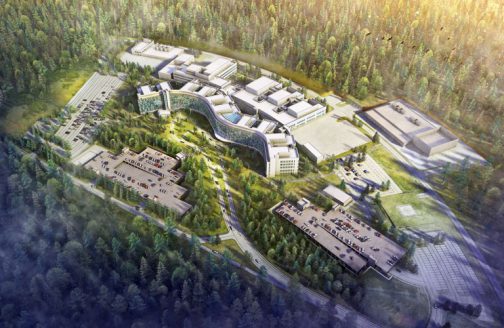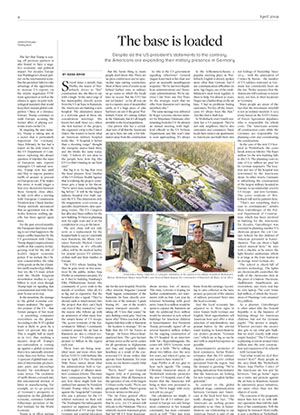Despite all the US president’s statements to the contrary, the Americans are expanding their military presence in Germany

Several times a month, Anja Pfeiffer, the mayor of Weilerbach, drives to “her” construction site, she likes to say with a laugh. At the outer edge of her municipality, directly across from the US air base in Ramstein, the Americans are building a new hospital. The diminutive mayor is a welcome guest at these site consultation meetings. She knows her stuff. Since 2011, when she first learned of the project, she organized a trip to the United States. She wanted to know what an American military hospital looks like. “A hospital is better than a shooting range,” thought the energetic mayor back then, and she thinks the same today. Only: “I believe it’s not clear to the people here how big this UFO is that’s landing in our back yard.”
But big it is. So big that even the head planner, Brad Dunbar of the US Defense Health Agency that is realizing the project, sometimes gets a lump in his throat. “We’ve never done something this big before.” It will be the largest military hospital ever built outside the US. The dimensions defy the imagination: 5,000 rooms, 42 specialty departments, nine operating rooms. The US Congress has allocated $990 million for the new building. It’s been in planning now for eight years and is set for completion in 2024 at the latest. The new clinic will not only serve as a replacement for the hospital built in 1953 in Landstuhl, near Ramstein; the Rhine Ordnance Barracks Medical Center Replacement, as it’s officially called, will be the medical facility for around 50,000 US soldiers, civilian staff and their families in Europe.
The UFO, whose landing has thus far gone more-or-less unnoticed by the public, strikes Anja Pfeiffer as sometimes uncanny. It’s as if they’re building Hamburg’s Elbe Philharmonic beside this community of 5,000 souls in the middle of nowhere. After all, it’s as big and as expensive. But the hospital is also a signal: “They’ve already sunk so much money into the project that they can’t back out, even if they wanted to,” says the mayor, who follows up with an admission of what many fear: the return home of US troops. The 53,000 residents of the Kaiserslautern Military Community centered around the air base in Ramstein are also a critical economic factor – US soldiers spend around €2 billion in the region each year.
These fears are being nourished more and more often. Just before NATO’s 70th birthday this year in April, US Vice President Mike Pence ranted about what his administration feels is Germany’s neglect of Alliance members’ common defense. This must have consequences, he warned, and how these might look was outlined last summer by President Donald Trump, when he railed against the “ungrateful” Germans who pay a pittance for the US soldiers stationed on their soil. The Washington Post subsequently reported on supposed plans for a withdrawal of US troops from Germany and a partial relocation of troops to Poland. Needless to say, the article caused quite a stir in the Palatinate.
Reality, however, tells a very different story. The Americans stationed in and around Ramstein and Kaiserslautern for 70 years came here to stay – and to invest. By 2019, over a half-billion euros had flowed into the West Palatinate locations for the expansion of the largest military air-traffic hub outside the US, for new schools and for the construction of the hospital.
But the funny thing is, many people don’t know this. There are no press conferences and no spectacular tape-cutting ceremonies. Most of these sorts of events occur behind barbed wire, in military no-go zones to which the locals have no access. But the UFO has not yet landed – so far, all you can see is a massive area of steamrolled earth, as if a huge piece of cake has been cut out of the green Weilerbach Forest. It’s raining dollars in the Palatinate, but it’s all largely invisible to the local population.
One person who has a crystal-clear view of all that the Americans are up to here sits only a few kilometers away from the construction site for the new hospital. From his office window, Brigadier General Mark August, commander of the Ramstein Air Base, directly overlooks one of the runways. A giant Boeing 767 – one of the world’s largest transport aircrafts – is taking off. “I love that sound,” he says, flashing a wide grin. “And you know why? When you look at the logistic hub that really is Ramstein – the location is strategic.” It’s no fluke that the US Air Forces in Europe – Air Forces Africa is headquartered here. The 1,400-hectare air base serves as the nerve center for all operations in Afghanistan and Iraq and regularly makes headlines as a result of the controversial US drone strikes that operate from Ramstein. Yet even today, no one knows exactly what goes on here.
“We’re here!” says General August, drily, as if pointing out the obvious. After all, Ramstein is the epicenter of one of the largest US bases in the world. “We’re not getting any smaller. There’s gonna be more airmen in this area.” The Air Force general offers some details, including the fact that by 2021, 700 US airmen will relocate to the Palatinate. This is a relatively modest statement given that last fall, US Army headquarters in Wiesbaden announced that an additional 1,500 soldiers will be stationed in Germany.
So why is the US government signaling otherwise? General August leans back in his chair and gives an unusually unambiguous response: “We’ve survived Republican administrations and Democratic administrations. We’ve survived Cold Wars and Hot Wars. So the strategic reach that we offer from Ramstein isn’t moving anywhere else.”
The same message was delivered by Roger Lewentz, interior minister for Rhineland-Palatinate, after returning from the US. He attends an annual meeting with high-level officials in the US Defense Department, and this year’s date is soon approaching. It’s always about money, lots of money. This time, Lewentz is hoping for further commitments, not statements with no bite. Last year he returned brimming with good news. Some $119 million would be spent to expand the Ramstein air hub. An additional $100 million would be invested in new school buildings for American children in Kaiserslautern. And President Trump personally signed off on several hundred million dollars for the ongoing construction of the US hospital. In an interview with Sat.1-Regionalmagazin, the center-left SPD’s Lewentz went out on a limb: “We’re talking about two billion over the next few years, and when it’s gone, no one wants to have wasted it.”
Anja Pfeiffer is all too glad to hear such signals. The young Christian Democrat mayor of Weilerbach tirelessly promotes the new US hospital, even if she knows that the Americans will bring in their own personnel to run it. “We’re happy with every new job we can get.”
Her calculations are simple. A hospital for all US military personnel in Europe not only brings more commerce to her tranquil community, but more consumer needs as well. “They may want to spend the night off the air base now and again, or just grab a bite to eat in town.”
In the Schlemmerscheune, a popular meeting place in Weilerbach, English is already spoken more often than German. And if any communication difficulties do arise, Sigi Degen, one of the establishment’s most loyal regulars, is there to help. For almost 50 years, Degen ran a barbershop on the air base. “I had no problems finding customers. We live off the Americans; it’s always been like that.” And like that it shall stay.
In Weilerbach, every fourth resident has a US passport. They’re not only neighbors, they’re also customers and consumers. Many locals have rented out apartments to Americans and built their own home from the earnings. According to data collected at the base, around 40 percent of the salaries of military personnel flows into the local economy.
And the local economy has adjusted to it. Most signs in town feature both German and English. Most supermarkets sell American beer and offer a wide selection of marshmallows and peanut butter. In the arterial roads leading to Kaiserslautern, car dealers promote “German cars,” which are as big as can be and with as much horsepower as possible.
Kaiserslautern’s promoter of local commerce, Stefan Weiler, estimates that the US military employs around 5,000 civilian personnel from the region. And the demand is growing: “We’re getting indications from industry that the Americans are looking for new venues to exploit further potential.”
In contrast to the global political stage, communication between Germans and Americans at the local level have not really changed. In fact: “The Americans are seeking greater proximity to us. Here in Kaiserslautern, our relationship to our American friends is part of our DNA.”
Yet he knows that US military interests cleave to strategic goals, not feelings of friendship. Since 2014 – with the annexation of Crimea by Russia – the number of US soldiers stationed in Germany has consistently been on the rise. Weiler assumes that the Americans will continue to invest more, not less, in their locations in Germany.
Many people are aware of the fact that the investment windfall is not an isolated incident. A 1975 treaty based on the NATO Status of Forces Agreement stipulates who is responsible for which costs. The Americans assume all construction costs, while the Germans are responsible for planning costs and coordinating the construction.
In the case of the new US hospital in Weilerbach, the costs break down as follows: The $990 million for the new building falls to the US. The planning costs to date of €151 million are paid for by German taxpayers. The location and size of the hospital was determined by the Americans alone. In other words, Germany is subsidizing the construction of the largest military hospital in Europe, to accommodate 50,000 US troops – and zero Germans. The 5,000 residents of Weilerbach will not be patients here.
“That’s not something that’s easy to communicate,” admits Marc Gutenberger, of the Federal Department of Construction, which has been involved in building for the Americans for decades. Gutenberger was essential in planning another US showcase project: the 21st Century School, for 850 children of American personnel in Kaiserslautern. “You can shoot a high school musical here,” he says with a chuckle, as he enters the light-flooded auditorium, which is as large as the train station in an average-sized German city.
The school is chock-full of modern technology. The lights are electronically controlled; the walls of the classrooms slide at the press of a button. Electronic chalkboards – Smartboards – are everywhere, and every seat has its own laptop. The cost? Some $48 million, of which the Association of Planning Costs assumed €6.5 million.
As a planner, Gutenberger is often asked why the Federal Republic is in the business of building things for American children, but not for German pupils: “The answer is simple: Whoever provides the money also gets to say what gets built. But we don’t exactly walk away empty-handed.” The US military is planning to invest around €650 million into the new construction and expansion of its schools – with German help.
“And what would we do if they weren’t here?” Many people in the area think like Weilerbach Mayor Anja Pfeiffer. Critics of the Americans are few and far between. “Ami go home” signs are a rarity, and protests against the air base in Ramstein, funded by nationwide peace initiatives, are more often than not the objects of scorn.
The concerns of the pragmatic mayor have less to do with military operations than with the daily lives of her constituents. Will the highway be widened? Heavy traffic is now a problem in Weilerbach. By the time the UFO has landed, there will be a bicycle path around the fenced-in grounds. “It’ll be sitting in the middle of our forest, and we have every right in the world to peek in.”
CRITICS OF DRONE CAMPAIGNS
The killing of alleged terrorists via US drone campaigns is controversial under international law. The role played by the US Ramstein Air Base remains unclear. Ramstein Air Base Commander Mark August denies that drone campaigns are planned or conducted from here: “There are no drones operating out of Ramstein Air Base.” In 2016, however, the German government conceded that it had knowledge of a relay station. For the US to carry out drone strikes in Yemen, the radio signals must be transmitted to the destination through Ramstein. In 2015, an American ex-drone pilot declared to a National Security Agency (NSA) committee of inquiry in Berlin that Ramstein plays a central role in drone warfare.
Nana Brink
is a Berlin-based freelance journalist for various newspapers and a radio reporter and moderator (Deutschlandfunk). She focuses on global politics, security policy and economic issues.




